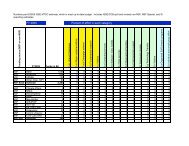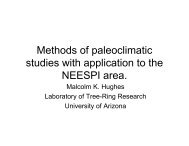Trends in extreme weather and climate events - Aspen Global ...
Trends in extreme weather and climate events - Aspen Global ...
Trends in extreme weather and climate events - Aspen Global ...
Create successful ePaper yourself
Turn your PDF publications into a flip-book with our unique Google optimized e-Paper software.
<strong>Trends</strong> <strong>in</strong> Extreme Weather<br />
<strong>and</strong> Climate Events: Issues Related<br />
to Model<strong>in</strong>g Extremes <strong>in</strong> Projections<br />
of Future Climate Change*<br />
Gerald A. Meehl, + Francis Zwiers, # Jenni Evans, @ Thomas Knutson, &<br />
L<strong>in</strong>da Mearns, + <strong>and</strong> Peter Whetton**<br />
ABSTRACT<br />
Projections of statistical aspects of <strong>weather</strong> <strong>and</strong> <strong>climate</strong> <strong>extreme</strong>s can be derived from <strong>climate</strong> models represent<strong>in</strong>g<br />
possible future <strong>climate</strong> states. Some of the recent models have reproduced results previously reported <strong>in</strong> the Intergovernmental<br />
Panel on Climate Change (IPCC) Second Assessment Report, such as a greater frequency of <strong>extreme</strong> warm<br />
days <strong>and</strong> lower frequency of <strong>extreme</strong> cold days associated with a warmer mean <strong>climate</strong>, a decrease <strong>in</strong> diurnal temperature<br />
range associated with higher nighttime temperatures, <strong>in</strong>creased precipitation <strong>in</strong>tensity, midcont<strong>in</strong>ent summer dry<strong>in</strong>g,<br />
decreas<strong>in</strong>g daily variability of surface temperature <strong>in</strong> w<strong>in</strong>ter, <strong>and</strong> <strong>in</strong>creas<strong>in</strong>g variability of northern midlatitude summer<br />
surface temperatures. This reconfirmation of previous results gives an <strong>in</strong>creased confidence <strong>in</strong> the credibility of the models,<br />
though agreement among models does not guarantee those changes will occur. New results s<strong>in</strong>ce the IPCC Second<br />
Assessment Report <strong>in</strong>dicate a possible <strong>in</strong>crease of <strong>extreme</strong> heat stress <strong>events</strong> <strong>in</strong> a warmer <strong>climate</strong>, an <strong>in</strong>crease of cool<strong>in</strong>g<br />
degree days <strong>and</strong> decrease <strong>in</strong> heat<strong>in</strong>g degree days, an <strong>in</strong>crease of precipitation <strong>extreme</strong>s such that there is a decrease <strong>in</strong><br />
return periods for 20-yr <strong>extreme</strong> precipitation <strong>events</strong>, <strong>and</strong> more detailed analyses of possible changes <strong>in</strong> 20-yr return<br />
values for <strong>extreme</strong> maximum <strong>and</strong> m<strong>in</strong>imum temperatures. Additionally, recent studies are now address<strong>in</strong>g <strong>in</strong>terannual<br />
<strong>and</strong> synoptic time <strong>and</strong> space scale processes that affect <strong>weather</strong> <strong>and</strong> <strong>climate</strong> <strong>extreme</strong>s, such as tropical cyclones, El Niño<br />
effects, <strong>and</strong> extratropical storms. However, current <strong>climate</strong> models are not yet <strong>in</strong> agreement with respect to possible future<br />
changes <strong>in</strong> such features.<br />
1. Introduction<br />
As part of the series of papers <strong>in</strong> this issue look<strong>in</strong>g<br />
at various aspects of <strong>weather</strong> <strong>and</strong> <strong>climate</strong> <strong>extreme</strong>s, the<br />
purpose of this paper is to summarize the state of our<br />
*This is the third of five papers <strong>in</strong> the “Underst<strong>and</strong><strong>in</strong>g Changes<br />
<strong>in</strong> Weather <strong>and</strong> Climate Extremes” series.<br />
+<br />
National Center for Atmospheric Research, Boulder, Colorado.<br />
#<br />
Canadian Centre for Modell<strong>in</strong>g <strong>and</strong> Analysis, Victoria, British<br />
Columbia, Canada.<br />
@<br />
Department of Meteorology, The Pennsylvania State University,<br />
University Park, Pennsylvania.<br />
&<br />
Geophysical Fluid Dynamics Laboratory, Pr<strong>in</strong>ceton, New Jersey.<br />
**CSIRO, <strong>Aspen</strong>dale, Victoria, Australia.<br />
Correspond<strong>in</strong>g author address: Dr. Gerald A. Meehl, Climate <strong>and</strong><br />
<strong>Global</strong> Dynamics Division, NCAR, P.O. Box 3000, Boulder, CO<br />
80307-3000.<br />
E-mail: meehl@ncar.ucar.edu<br />
In f<strong>in</strong>al form 6 August 1999.<br />
©2000 American Meteorological Society<br />
knowledge of possible future changes <strong>in</strong> the statistical<br />
aspects of <strong>weather</strong> <strong>and</strong> <strong>climate</strong> <strong>extreme</strong>s. A def<strong>in</strong>ition<br />
<strong>and</strong> conceptual discussion of such <strong>extreme</strong>s is<br />
given <strong>in</strong> the <strong>in</strong>troductory paper <strong>in</strong> this series (Meehl<br />
et al. 2000). Possible future changes of <strong>weather</strong> <strong>and</strong><br />
<strong>climate</strong> <strong>extreme</strong>s are derived by compar<strong>in</strong>g <strong>climate</strong><br />
model simulations of naturally occurr<strong>in</strong>g <strong>climate</strong> variability<br />
to future simulated <strong>climate</strong> states with atmospheric<br />
constituents affected by human activity (e.g.,<br />
<strong>in</strong>creased greenhouse gases, sulfate aerosols, etc.). We<br />
will del<strong>in</strong>eate recent model studies that have reconfirmed<br />
results reported <strong>in</strong> the Intergovernmental Panel<br />
on Climate Change (IPCC) Second Assessment Report<br />
(Houghton et al. 1996), <strong>and</strong> identify new results<br />
that have emerged s<strong>in</strong>ce the publication of that report.<br />
The focus of earlier <strong>climate</strong> model studies of global<br />
warm<strong>in</strong>g was ma<strong>in</strong>ly on changes <strong>in</strong> mean <strong>climate</strong><br />
(e.g., Houghton et al. 1990). It has been only s<strong>in</strong>ce the<br />
early 1990s that <strong>climate</strong> models have started to be analyzed<br />
to study possible changes of future <strong>weather</strong> <strong>and</strong><br />
Bullet<strong>in</strong> of the American Meteorological Society<br />
427
<strong>climate</strong> <strong>extreme</strong>s (Houghton et al. 1996). The last several<br />
years have seen even more of these types of studies<br />
as the models have improved enough to at least<br />
beg<strong>in</strong> to look at such higher-order features <strong>in</strong> more<br />
detail. This is a product of the rapid development of<br />
<strong>climate</strong> model<strong>in</strong>g capabilities over the past 10 years,<br />
<strong>in</strong> concert with <strong>in</strong>creased computer resources. The<br />
current generation of global coupled <strong>climate</strong> models<br />
have improved resolution (grid po<strong>in</strong>ts typically every<br />
2.5° of latitude <strong>and</strong> longitude), more detailed <strong>and</strong> accurate<br />
l<strong>and</strong> surface simulation schemes, <strong>and</strong> dynamical<br />
sea ice formulations. Some have even higher<br />
resolution <strong>in</strong> the ocean near the equator (lead<strong>in</strong>g to<br />
improved simulations of El Niño). These changes are<br />
coupled with improved techniques to study <strong>climate</strong><br />
changes <strong>and</strong> <strong>climate</strong> processes at smaller regional<br />
scales from general circulation model (GCM) results<br />
through either embedd<strong>in</strong>g high-resolution regional<br />
models (with grid po<strong>in</strong>ts every 50 km or so) <strong>in</strong> the<br />
global models or statistical downscal<strong>in</strong>g techniques.<br />
Consequently, possible future changes of <strong>extreme</strong> <strong>climate</strong><br />
<strong>and</strong> <strong>weather</strong> <strong>events</strong> <strong>in</strong> these models are a current<br />
focus of the IPCC Third Assessment Report, which is<br />
slated to be published <strong>in</strong> early 2001.<br />
Though the models have improved over time, they<br />
still have limitations <strong>in</strong> terms of spatial resolution,<br />
simulation errors, <strong>and</strong> parameterizations that must represent<br />
processes that cannot yet be <strong>in</strong>cluded explicitly<br />
<strong>in</strong> the models, particularly deal<strong>in</strong>g with clouds <strong>and</strong><br />
precipitation. Thus we have vary<strong>in</strong>g degrees of confidence<br />
<strong>in</strong> many of the quantitative aspects of the model<br />
simulations. However, the models are able to qualitatively<br />
reproduce many of the features of the observed<br />
<strong>climate</strong> system not only <strong>in</strong> terms of means but also<br />
naturally occurr<strong>in</strong>g variability (Tett et al. 1997).<br />
Coupled models appear to be produc<strong>in</strong>g <strong>in</strong>creas<strong>in</strong>gly<br />
realistic simulations of the <strong>climate</strong> changes that already<br />
have been observed <strong>in</strong> the twentieth century. For<br />
example, a recent global <strong>climate</strong> model study f<strong>in</strong>ds that<br />
greenhouse gases, sulfate aerosols, <strong>and</strong> solar variability<br />
may have all played important roles <strong>in</strong> twentieth<br />
century <strong>climate</strong> change (Tett et al. 1999). Paleo<strong>climate</strong><br />
simulations with the same models used for project<strong>in</strong>g<br />
future <strong>climate</strong> changes <strong>in</strong>dicate that many of the features<br />
of past <strong>climate</strong>s also can be simulated (Gates et<br />
al. 1996). Thus we have <strong>in</strong>creas<strong>in</strong>g confidence that<br />
today’s <strong>climate</strong> models can provide plausible firstorder<br />
projections of changes that could occur <strong>in</strong> a future<br />
<strong>climate</strong> altered by human activity.<br />
S<strong>in</strong>ce the publication of the IPCC Second Assessment<br />
Report <strong>in</strong> early 1996, subsequent model<strong>in</strong>g studies<br />
have reproduced a number of the model results<br />
reported <strong>in</strong> that report. For example, an <strong>in</strong>crease <strong>in</strong><br />
mean temperatures leads to more <strong>extreme</strong> high temperatures<br />
<strong>and</strong> less <strong>extreme</strong> low temperatures. Nighttime<br />
low temperatures <strong>in</strong> many regions <strong>in</strong>crease more than<br />
daytime highs, thus reduc<strong>in</strong>g the diurnal temperature<br />
range. Decreased daily variability of temperature <strong>in</strong><br />
w<strong>in</strong>ter <strong>and</strong> <strong>in</strong>creased variability <strong>in</strong> summer <strong>in</strong> Northern<br />
Hemisphere midlatitude areas significantly modify<br />
changes <strong>in</strong> <strong>extreme</strong>s. Increased moisture content <strong>in</strong><br />
many regions contributes to <strong>in</strong>creased precipitation<br />
<strong>in</strong>tensity. There is a general dry<strong>in</strong>g of the midcont<strong>in</strong>ental<br />
areas dur<strong>in</strong>g summer with <strong>in</strong>creased<br />
chance of drought, <strong>and</strong> this is ascribed to a comb<strong>in</strong>ation<br />
of <strong>in</strong>creased temperature <strong>and</strong> evaporation along<br />
with decreased precipitation.<br />
This paper is organized to address possible changes<br />
of <strong>extreme</strong>s phenomenologically. In subsequent sections<br />
we will note the more recent studies that reproduce<br />
the previous results, <strong>and</strong> will identify new results<br />
regard<strong>in</strong>g possible future changes of <strong>weather</strong> <strong>and</strong> <strong>climate</strong><br />
<strong>extreme</strong>s <strong>in</strong> a warmer <strong>climate</strong>.<br />
2. Temperature<br />
One of the earlier results perta<strong>in</strong><strong>in</strong>g to changes of<br />
temperature <strong>extreme</strong>s was that higher mean temperatures<br />
<strong>in</strong>crease the probability of <strong>extreme</strong> warm days<br />
<strong>and</strong> decrease the probability of <strong>extreme</strong> cold days (e.g.,<br />
listed as a “probable projection” by Mahlman 1997)<br />
unless a compensat<strong>in</strong>g decrease <strong>in</strong> st<strong>and</strong>ard deviation<br />
or skewness occurs. This result has been reconfirmed<br />
by more recent studies. For example, a high-resolution<br />
regional model over southeastern Australia nested <strong>in</strong><br />
a global model run under a transient enhanced greenhouse<br />
scenario shows that the frequency of m<strong>in</strong>imum<br />
temperatures below freez<strong>in</strong>g was roughly halved when<br />
the mean m<strong>in</strong>imum temperature <strong>in</strong>creased by nearly<br />
2°C (Hennessy et al. 1998). Increases <strong>in</strong> m<strong>in</strong>imum<br />
temperature have appeared consistently <strong>in</strong> a number<br />
of different <strong>climate</strong> models <strong>and</strong> also are associated<br />
with an observed decrease <strong>in</strong> diurnal temperature range<br />
<strong>in</strong> some areas (Karl <strong>and</strong> Knight 1998).<br />
New aspects of temperature <strong>extreme</strong> changes have<br />
been explored with more detailed statistical analyses<br />
of <strong>climate</strong> model experiments. For example, the pattern<br />
of change <strong>in</strong> return values of 20-yr <strong>extreme</strong> temperature<br />
<strong>events</strong> from an equilibrium simulation for<br />
doubled CO 2<br />
with a global atmospheric model coupled<br />
to a nondynamic slab ocean shows moderate <strong>in</strong>creases<br />
428 Vol. 81, No. 3, March 2000
FIG. 1. The change <strong>in</strong> 20-yr return values for <strong>extreme</strong> daily maximum (upper panel) <strong>and</strong> m<strong>in</strong>imum (lower panel) surface air temperature<br />
(or screen temperature) for the equilibrium response to a doubl<strong>in</strong>g of CO 2<br />
<strong>in</strong> a global atmospheric model coupled to a slab<br />
ocean (from Zwiers <strong>and</strong> Khar<strong>in</strong> 1998). Contour <strong>in</strong>terval is 2°C <strong>in</strong> top panel <strong>and</strong> 4°C <strong>in</strong> lower panel. Light (dark) shad<strong>in</strong>g <strong>in</strong>dicates<br />
regions <strong>in</strong> which the 20-yr return value has <strong>in</strong>creased by at least 4°C (8°C) for maxima, <strong>and</strong> at least 8°C (16°C) for m<strong>in</strong>ima.<br />
over oceans <strong>and</strong> larger <strong>in</strong>creases over l<strong>and</strong>masses<br />
(Fig. 1; Zwiers <strong>and</strong> Khar<strong>in</strong> 1998). The greatest change<br />
<strong>in</strong> the 20-yr return values of daily maximum temperature<br />
(Fig. 1a) is found <strong>in</strong> central <strong>and</strong> southeast North<br />
America, central <strong>and</strong> southeast Asia, <strong>and</strong> tropical Africa<br />
where there is a decrease <strong>in</strong> soil moisture content.<br />
Large <strong>extreme</strong> temperature <strong>in</strong>creases also are seen over<br />
the dry surface of north Africa. In contrast, the west<br />
coast of North America is affected by <strong>in</strong>creased precipitation<br />
result<strong>in</strong>g <strong>in</strong> moister soil <strong>and</strong> more moder-<br />
Bullet<strong>in</strong> of the American Meteorological Society<br />
429
ate <strong>in</strong>creases <strong>in</strong> <strong>extreme</strong> temperature. There are small<br />
areas of decrease <strong>in</strong> the Labrador Sea <strong>and</strong> Southern Ocean<br />
that are associated with changes <strong>in</strong> ocean circulation.<br />
The changes <strong>in</strong> the return values of daily m<strong>in</strong>imum<br />
temperature (Fig. 1b) are larger than those of daily<br />
maximum temperature over l<strong>and</strong> areas <strong>and</strong> highlatitude<br />
oceans where snow <strong>and</strong> ice retreat. Somewhat<br />
larger changes are found over l<strong>and</strong>masses <strong>and</strong> the Arctic,<br />
while smaller <strong>in</strong>creases <strong>in</strong> <strong>extreme</strong> m<strong>in</strong>imum temperatures<br />
occur at the marg<strong>in</strong>s of the polar oceans.<br />
Thus, there is some asymmetry between the change <strong>in</strong><br />
the <strong>extreme</strong>s of m<strong>in</strong>imum <strong>and</strong> maximum temperature<br />
(with a bigger <strong>in</strong>crease for m<strong>in</strong>ima than maxima). This<br />
has to do with the change <strong>in</strong> the nature of the contact<br />
between atmosphere <strong>and</strong> the surface (e.g., m<strong>in</strong>ima <strong>in</strong>crease<br />
sharply where ice <strong>and</strong> snow cover have retreated<br />
expos<strong>in</strong>g either ocean or l<strong>and</strong>; maxima <strong>in</strong>crease more<br />
where the l<strong>and</strong> surface has dried).<br />
Increased temperature variance adds to the probability<br />
of <strong>extreme</strong> high-temperature <strong>events</strong> over <strong>and</strong><br />
above simply what could be expected from <strong>in</strong>creases<br />
of mean alone. Simulations suggest that both mean <strong>and</strong><br />
variance are likely to change with a changed <strong>climate</strong>,<br />
<strong>and</strong> the relative contribution of the mean <strong>and</strong> variance<br />
changes depends on how much each moment changes.<br />
Earlier studies showed <strong>in</strong>creased variance of daily temperature<br />
<strong>in</strong> summer <strong>in</strong> northern midcont<strong>in</strong>ental areas<br />
<strong>in</strong> regional model experiments (Mearns et al. 1995),<br />
<strong>in</strong> global models (Gregory <strong>and</strong> Mitchell 1995), <strong>and</strong><br />
also <strong>in</strong> the more recent global model noted previously<br />
<strong>in</strong> Fig. 1 (Zwiers <strong>and</strong> Khar<strong>in</strong> 1998).<br />
The change <strong>in</strong> the mean is usually larger than the<br />
change <strong>in</strong> variance for most <strong>climate</strong> change simulations.<br />
This was the case <strong>in</strong> the Australian example cited<br />
above. However, the change <strong>in</strong> variance provides important<br />
further modifications. For example, a recent<br />
regional <strong>climate</strong> change experiment shows that the<br />
change <strong>in</strong> the mean may <strong>in</strong>crease the probability of<br />
<strong>extreme</strong> warm days <strong>in</strong> Iowa by an order of magnitude;<br />
account<strong>in</strong>g for the change <strong>in</strong> variance further <strong>in</strong>creases<br />
the probability (Giorgi et al. 1998).<br />
Another recent model study shows an <strong>in</strong>crease of<br />
about 5°C <strong>in</strong> a July mean “heat <strong>in</strong>dex” (a measure that<br />
<strong>in</strong>cludes both the effects of temperature <strong>and</strong> moisture)<br />
over the southeastern United States by the year 2050<br />
(Delworth et al. 1999). An upward trend <strong>in</strong> the frequency<br />
of <strong>extreme</strong> heat stress <strong>events</strong> over the eastern<br />
United States has been reported <strong>in</strong> the observations<br />
(Gaffen <strong>and</strong> Ross 1998). Changes <strong>in</strong> the heat<strong>in</strong>g <strong>and</strong><br />
cool<strong>in</strong>g degree days are another likely <strong>extreme</strong> temperature-related<br />
effect of future greenhouse warm<strong>in</strong>g.<br />
For example, a recent analysis of these measures <strong>in</strong> one<br />
global <strong>climate</strong> model shows a decrease <strong>in</strong> heat<strong>in</strong>g degree<br />
days for Canada <strong>and</strong> an <strong>in</strong>crease <strong>in</strong> cool<strong>in</strong>g degree<br />
days <strong>in</strong> the southwest United States <strong>in</strong> a future<br />
<strong>climate</strong> with <strong>in</strong>creased greenhouse gases (Zwiers <strong>and</strong><br />
Khar<strong>in</strong> 1998).<br />
Earlier <strong>climate</strong> models also projected decreased<br />
variability of daily temperature <strong>in</strong> w<strong>in</strong>ter <strong>in</strong> northern<br />
temperate midcont<strong>in</strong>ental regions (Mearns et al. 1995;<br />
Gregory <strong>and</strong> Mitchell 1995). Such a decrease would<br />
further reduce cold <strong>extreme</strong>s, as noted previously,<br />
which are primarily reduced by the <strong>in</strong>creased mean of<br />
the daily m<strong>in</strong>imum temperature.<br />
3. Precipitation<br />
Increased precipitation <strong>in</strong>tensity (albeit with certa<strong>in</strong><br />
regional variations) <strong>in</strong> a future <strong>climate</strong> with <strong>in</strong>creased<br />
greenhouse gases was one of the earliest model<br />
results regard<strong>in</strong>g precipitation <strong>extreme</strong>s, <strong>and</strong> rema<strong>in</strong>s<br />
a consistent result with improved, more detailed models<br />
(Kothavala 1997; Hennessy et al. 1997; Durman<br />
et al. 2000, unpublished manuscript). There are also<br />
some <strong>in</strong>dications from observations that such changes<br />
of precipitation <strong>in</strong>tensity are already be<strong>in</strong>g seen <strong>in</strong><br />
some regions (Karl <strong>and</strong> Knight 1998). There have been<br />
questions regard<strong>in</strong>g the relatively coarse spatial scale<br />
resolution <strong>in</strong> <strong>climate</strong> models be<strong>in</strong>g able to represent<br />
essentially mesoscale <strong>and</strong> smaller precipitation processes.<br />
However, the globally averaged <strong>in</strong>crease <strong>in</strong><br />
moisture capacity of a warmer atmosphere is physically<br />
consistent with <strong>in</strong>creases <strong>in</strong> precipitation <strong>and</strong>,<br />
potentially, with <strong>in</strong>creases of precipitation rate <strong>in</strong> some<br />
regions.<br />
It has been recognized recently that changes <strong>in</strong> precipitation<br />
<strong>in</strong>tensity could have a geographical dependence.<br />
For example, Bhaskharan <strong>and</strong> Mitchell (1998)<br />
note that range of precipitation <strong>in</strong>tensity over the south<br />
Asian monsoon region broadens <strong>in</strong> a future <strong>climate</strong><br />
experiment with <strong>in</strong>creased greenhouse gases, with<br />
decreases prevalent <strong>in</strong> the west <strong>and</strong> <strong>in</strong>creases more<br />
widespread <strong>in</strong> the east. Increases <strong>in</strong> <strong>extreme</strong> precipitation<br />
<strong>events</strong> recently have been projected <strong>in</strong> nested regional<br />
models over Australia (Hennessy et al. 1998)<br />
<strong>and</strong> the United States (Giorgi et al. 1998), <strong>and</strong> <strong>in</strong> a<br />
high-resolution nested hurricane model over the northwest<br />
tropical Pacific (Knutson <strong>and</strong> Tuleya 1999). In a<br />
recent global model simulation with doubled CO 2<br />
,<br />
precipitation <strong>extreme</strong>s <strong>in</strong>crease more than the mean<br />
(the mean <strong>in</strong>crease is 4%; 20-yr <strong>extreme</strong> precipitation<br />
430 Vol. 81, No. 3, March 2000
event return values <strong>in</strong>crease 11%) with a consequent<br />
decrease <strong>in</strong> return period for the 20-yr <strong>extreme</strong> precipitation<br />
<strong>events</strong> almost everywhere (e.g., to 10 years over<br />
North America; Zwiers <strong>and</strong> Khar<strong>in</strong> 1998).<br />
Earlier model<strong>in</strong>g studies <strong>in</strong>dicated <strong>in</strong>creased yearto-year<br />
seasonal precipitation variability for the Indian<br />
monsoon <strong>in</strong> a warmer <strong>climate</strong> (Meehl <strong>and</strong> Wash<strong>in</strong>gton<br />
1993). This result also has been noted <strong>in</strong> more recent<br />
studies (Kitoh et al. 1997). Although changes <strong>in</strong><br />
future mean Indian monsoon strength depend on the<br />
details of the forc<strong>in</strong>g scenario <strong>and</strong> model, a change <strong>in</strong><br />
<strong>in</strong>terannual variability has implications for <strong>in</strong>creas<strong>in</strong>g<br />
the likelihood of drought <strong>and</strong> flood dur<strong>in</strong>g the monsoon<br />
season. There are also implications for tropical<br />
cyclone activity <strong>in</strong> the Asia–Pacific region.<br />
Another long-st<strong>and</strong><strong>in</strong>g model result regard<strong>in</strong>g<br />
drought (a general dry<strong>in</strong>g of the midcont<strong>in</strong>ental areas<br />
dur<strong>in</strong>g summer with <strong>in</strong>creas<strong>in</strong>g CO 2<br />
) has been reproduced<br />
with the latest generation of global coupled <strong>climate</strong><br />
models (Haywood et al. 1997; Wetherald <strong>and</strong><br />
Manabe 1999). This <strong>in</strong>creased chance of drought dur<strong>in</strong>g<br />
summer generally is attributed to a comb<strong>in</strong>ation<br />
of <strong>in</strong>creased temperature <strong>and</strong> evaporation along with<br />
decreased precipitation. To more quantitatively address<br />
this problem, a recent global <strong>climate</strong> model with<br />
<strong>in</strong>creased CO 2<br />
was analyzed to show large <strong>in</strong>creases<br />
<strong>in</strong> frequency of low summer precipitation, the<br />
probabilityof dry soil, <strong>and</strong> the occurrence of long dry<br />
spells (Gregory et al. 1997). The latter was ascribed<br />
to the reduction of ra<strong>in</strong>fall <strong>events</strong> <strong>in</strong> the model rather<br />
than to decreases <strong>in</strong> mean precipitation.<br />
4. Extratropical storms<br />
Storms have severe impacts associated with <strong>extreme</strong>s<br />
of temperature, precipitation, w<strong>in</strong>d, <strong>and</strong> waves.<br />
However, because of limitations <strong>in</strong> previous generations<br />
of global <strong>climate</strong> models, until recently there<br />
have been few studies of future changes <strong>in</strong> the frequency,<br />
location, <strong>and</strong> strength of extratropical storms.<br />
With the improved recent generation of global <strong>climate</strong><br />
models, such studies are now becom<strong>in</strong>g more credible,<br />
but results are still mixed. An analysis of an ensemble<br />
of four future <strong>climate</strong> change experiments <strong>in</strong> a global<br />
coupled model with <strong>in</strong>creased CO 2<br />
<strong>and</strong> sulfate aerosols<br />
showed a decrease <strong>in</strong> the total number of Northern<br />
Hemisphere storms, but an <strong>in</strong>crease <strong>in</strong> the number<br />
of the most <strong>in</strong>tense storms (Fig. 2; Carnell <strong>and</strong> Senior<br />
1998). This is consistent with results found <strong>in</strong> the<br />
Southern Hemisphere for midlatitude cyclones off the<br />
east coast of Australia (Katzfey <strong>and</strong> McInnes 1996).<br />
A storm track analysis of a GCM with doubled CO 2<br />
<strong>in</strong>dicates a northeastward shift of storm frequency <strong>in</strong><br />
the North Atlantic, with little change <strong>in</strong> storm <strong>in</strong>tensities<br />
(Schubert et al. 1998), though another study<br />
found a reduction of <strong>in</strong>tensity (Beersma et al. 1997),<br />
<strong>and</strong> still another found an <strong>in</strong>crease (Lunkeit et al.<br />
1996). An <strong>in</strong>crease <strong>in</strong> upper-air storm track activity<br />
(with implied <strong>in</strong>creases <strong>in</strong> <strong>extreme</strong>s associated with the<br />
greater number of storms) over the east Atlantic <strong>and</strong><br />
western Europe with ris<strong>in</strong>g greenhouse gas forc<strong>in</strong>g has<br />
been related to a change <strong>in</strong> the North Atlantic oscillation<br />
(Ulbrich <strong>and</strong> Christoph 1999). Longer time series<br />
from models have made the statistics more robust (e.g.,<br />
Carnell <strong>and</strong> Senior 1998). High-resolution models may<br />
improve the simulation <strong>in</strong> the control runs, but the<br />
length of experiments may be too short for <strong>in</strong>dications<br />
of significant changes (e.g., Beersma et al. 1997).<br />
Consequently, several studies have tried to look <strong>in</strong><br />
more detail at mechanisms. For example, Christoph<br />
et al. (1997) identify a midw<strong>in</strong>ter suppression of the<br />
North Pacific storm track <strong>in</strong> present-day <strong>climate</strong>, which<br />
they attribute to very strong upper-level w<strong>in</strong>ds at that<br />
time of year. Then <strong>in</strong> a 3xCO 2<br />
<strong>climate</strong> model experiment,<br />
they note that very <strong>in</strong>tense upper-level w<strong>in</strong>ds<br />
occur more often, thus produc<strong>in</strong>g a more pronounced<br />
midw<strong>in</strong>ter suppression of the Pacific storm track.<br />
As can be seen, there are now a grow<strong>in</strong>g number<br />
of studies address<strong>in</strong>g possible changes <strong>in</strong> storm activity,<br />
but there is little agreement as yet between the<br />
models concern<strong>in</strong>g the possible future behavior of<br />
storms <strong>in</strong> a warmer <strong>climate</strong>.<br />
5. El Niño–Southern Oscillation (ENSO)<br />
ENSO is associated with strong year-to-year <strong>climate</strong><br />
variations <strong>in</strong> many parts of the world. Several<br />
aspects could affect future <strong>climate</strong> <strong>extreme</strong>s: Will the<br />
long-term mean Pacific <strong>climate</strong> shift toward a more<br />
El Niño–like or La Niña–like regime Will El Niño<br />
variability (the amplitude <strong>and</strong>/or the frequency of temperature<br />
sw<strong>in</strong>gs <strong>in</strong> equatorial Pacific) <strong>in</strong>crease or decrease<br />
How will El Niño’s impact on <strong>weather</strong> <strong>in</strong> the<br />
Pacific bas<strong>in</strong> <strong>and</strong> other parts of the world change<br />
Current global <strong>climate</strong> models are able to simulate<br />
a number of aspects of El Niño–like phenomena<br />
(Meehl <strong>and</strong> Arblaster 1998; Timmermann et al. 1999;<br />
Coll<strong>in</strong>s 2000). Results from several earlier global <strong>climate</strong><br />
model studies <strong>in</strong>dicated that as global temperatures<br />
rise due to <strong>in</strong>creased greenhouse gases, the mean<br />
Bullet<strong>in</strong> of the American Meteorological Society<br />
431
FIG. 2. Changes <strong>in</strong> the number of Northern Hemisphere storm tracks per 90-day northern w<strong>in</strong>ter season [December–January–February<br />
(DJF)] for two time periods <strong>in</strong> the future <strong>in</strong> a set of global <strong>climate</strong> change experiments. Dark shad<strong>in</strong>g (first peak from left of each<br />
group): DJF (2006–36), ensemble mean of a greenhouse gas plus sulfate aerosol experiment (SUL) m<strong>in</strong>us a control (CON) experiment.<br />
Medium dark shad<strong>in</strong>g (second from left): DJF (2006–36) ensemble mean of a greenhouse gas <strong>in</strong>crease only experiment (GHG)<br />
m<strong>in</strong>us CON. Medium light shad<strong>in</strong>g (third from left): DJF (2070–2100) ensemble mean of SUL m<strong>in</strong>us CON. Light shad<strong>in</strong>g (fourth<br />
from left): DJF (2070–2100) ensemble mean of GHG (2070–2100) m<strong>in</strong>us CON. Horizontal bars at the end of the peaks show changes<br />
that are significant at the 1% level. Note that the number of shallow <strong>and</strong> medium storm tracks decreases <strong>in</strong> the future <strong>climate</strong> change<br />
experiments, while the number of deep storm tracks <strong>in</strong>creases <strong>in</strong> this particular model (Carnell <strong>and</strong> Senior 1998).<br />
Pacific <strong>climate</strong> will tend to more resemble an El Niño–<br />
like state with greater relative surface warm<strong>in</strong>g <strong>in</strong> the<br />
equatorial eastern Pacific than the west (Meehl <strong>and</strong><br />
Wash<strong>in</strong>gton 1996; Knutson <strong>and</strong> Manabe 1995). More<br />
recent studies also have shown this result (Knutson <strong>and</strong><br />
Manabe 1998; Timmermann et al. 1999). It has been<br />
shown this conclusion could be dependent on the<br />
model representation of cloud feedbacks <strong>in</strong> compar<strong>in</strong>g<br />
a global coupled model with an El Niño–like response<br />
to one with uniform warm<strong>in</strong>g across the<br />
tropical Pacific (Meehl et al. 2000). Additionally,<br />
though one model shows a La Niña–like response<br />
(Noda et al. 1999), another shows an <strong>in</strong>itial La Niña–<br />
like pattern that eventually transitions to an El Niño–<br />
like pattern due to subducted warmed extratropical<br />
water that penetrates through the subtropics <strong>in</strong>to the<br />
Tropics (Cai <strong>and</strong> Whetton 1999, manuscript submitted<br />
to Geophys. Res. Letts.).<br />
Concern<strong>in</strong>g El Niño’s effects on <strong>weather</strong>, it previously<br />
has been shown that a warmer base state would<br />
result <strong>in</strong> future El Niño–related seasonal precipitation<br />
sw<strong>in</strong>gs that are more <strong>extreme</strong> (Meehl et al. 1993).<br />
Thus, areas <strong>in</strong> the tropical Pacific <strong>and</strong> Indian Ocean<br />
regions that are anomalously wet dur<strong>in</strong>g El Niño could<br />
become wetter, <strong>and</strong> anomalously dry areas would become<br />
drier dur<strong>in</strong>g future El Niño <strong>events</strong>. These<br />
changes <strong>in</strong> <strong>extreme</strong>s <strong>in</strong> dry spells have been noted<br />
more recently to have serious consequences, for example,<br />
for water resources on small Pacific isl<strong>and</strong>s<br />
(Meehl 1996).<br />
Previous attempts to address the question of future<br />
changes <strong>in</strong> El Niño SST variability us<strong>in</strong>g <strong>climate</strong><br />
432 Vol. 81, No. 3, March 2000
models <strong>in</strong>dicated little change or a modest reduction<br />
<strong>in</strong> amplitude of future El Niño <strong>events</strong> (e.g., Knutson<br />
et al. 1997). However, two recent studies us<strong>in</strong>g somewhat<br />
higher resolution models predict a somewhat<br />
greater amplitude of future El Niño/La Niña <strong>events</strong> due<br />
to a strengthen<strong>in</strong>g of the equatorial Pacific thermocl<strong>in</strong>e<br />
(Timmermann et al. 1999; Coll<strong>in</strong>s 2000). Recent studies<br />
also have <strong>in</strong>dicated that El Niño–like SST patterns<br />
can apparently occur at a variety of timescales rang<strong>in</strong>g<br />
from <strong>in</strong>terannual to <strong>in</strong>terdecadal (Zhang et al.<br />
1997; Lau <strong>and</strong> Weng 1999) <strong>in</strong> addition to possible<br />
El Niño–like changes to the mean <strong>climate</strong> <strong>in</strong> response<br />
to external forc<strong>in</strong>gs such as <strong>in</strong>creased CO 2<br />
(see discussion<br />
above). Mak<strong>in</strong>g conclusions about “changes” <strong>in</strong><br />
future El Niño <strong>events</strong> is complicated by these factors.<br />
Additionally, s<strong>in</strong>ce substantial <strong>in</strong>ternally generated<br />
variability of El Niño statistics on multidecadal to<br />
century timescales occurs <strong>in</strong> observations (Allan et al.<br />
1996) <strong>and</strong> <strong>in</strong> long unforced <strong>climate</strong> model simulations<br />
(Knutson et al. 1997), the attribution of past <strong>and</strong> future<br />
changes <strong>in</strong> El Niño amplitude <strong>and</strong> frequency to<br />
specific causes may be quite difficult.<br />
Although there are now better El Niño simulations<br />
<strong>in</strong> global coupled <strong>climate</strong> models, further model improvements<br />
are needed to simulate a more realistic Pacific<br />
climatology <strong>and</strong> seasonal cycle as well as more<br />
realistic El Niño variability. Such improvements will<br />
be necessary to ga<strong>in</strong> further confidence <strong>in</strong> <strong>climate</strong><br />
model projections.<br />
6. Tropical cyclones<br />
Greenhouse gas–<strong>in</strong>duced <strong>climate</strong> warm<strong>in</strong>g potentially<br />
could affect tropical cyclones <strong>in</strong> a number of<br />
ways, <strong>in</strong>clud<strong>in</strong>g their <strong>in</strong>tensity, frequency of occurrence,<br />
geographical distribution, <strong>and</strong> storm tracks.<br />
Concern<strong>in</strong>g future changes <strong>in</strong> tropical cyclone frequency,<br />
no consensus has emerged yet among global<br />
models, although two recent studies of this issue employ<strong>in</strong>g<br />
relatively high-resolution global <strong>climate</strong> models<br />
(approximately 1°) both <strong>in</strong>dicate a decrease <strong>in</strong><br />
tropical storm frequency <strong>in</strong> a CO 2<br />
-warmed <strong>climate</strong><br />
(Bengtsson et al. 1996; Yoshimura et al. 1999). The<br />
merits of us<strong>in</strong>g current global <strong>climate</strong> models to<br />
project future changes <strong>in</strong> tropical storm frequency has<br />
been the subject of active debate (e.g., Henderson-<br />
Sellers et al. 1998).<br />
Regard<strong>in</strong>g tropical cyclone <strong>in</strong>tensities, some of the<br />
global <strong>climate</strong> models suggest an <strong>in</strong>crease of <strong>in</strong>tensities<br />
with CO 2<br />
-<strong>in</strong>duced warm<strong>in</strong>g (Krishnamurti et al.<br />
1998). However, the highest resolution global <strong>climate</strong><br />
model experiment reported to date (Bengtsson et al.<br />
1996) still has a resolution too coarse (1°) to simulate<br />
the most <strong>in</strong>tense storms <strong>and</strong>/or realistically simulate<br />
structures such as the hurricane eye. Recent experiments<br />
with a nested high-resolution regional model<br />
(resolution of up to 1/6 degree or 18 km) <strong>in</strong>dicate a<br />
5%–11% <strong>in</strong>crease <strong>in</strong> surface w<strong>in</strong>d speeds <strong>and</strong> a 28%<br />
<strong>in</strong>crease <strong>in</strong> near-storm precipitation, based on a comparison<br />
of strong north Pacific typhoons simulated<br />
under present day <strong>and</strong> high CO 2<br />
conditions (Knutson<br />
et al. 1998; Knutson <strong>and</strong> Tuleya 1999). This simulated<br />
<strong>in</strong>crease of w<strong>in</strong>d speeds is similar to the <strong>in</strong>crease <strong>in</strong><br />
tropical cyclone upper-limit <strong>in</strong>tensities predicted by<br />
theories based on thermodynamic considerations<br />
(Henderson-Sellers et al. 1998; Emanuel 1987). In<br />
other applications of regional embedded models, highresolution<br />
experiments for the Australian region have<br />
shown similar <strong>in</strong>creases <strong>in</strong> tropical cyclone <strong>in</strong>tensity<br />
as well as possible poleward shifts <strong>in</strong> occurrence<br />
(Walsh <strong>and</strong> Ryan 1999). This approach, along with<br />
higher-resolution global model experiments, holds<br />
promise for better estimates of future tropical cyclone<br />
behavior.<br />
Indices of tropical cyclone activity (Gray 1975)<br />
summarize the necessary large-scale conditions for<br />
tropical cyclone activity, even for coarse-resolution<br />
GCMs (Evans <strong>and</strong> Kempisty 1998; Royer et al. 1998).<br />
Climate change studies to date show a great sensitivity<br />
to the measure of convective activity chosen, with<br />
little change <strong>in</strong> the fields relat<strong>in</strong>g to dynamical organization.<br />
Additionally, s<strong>in</strong>ce tropical storm activity <strong>in</strong><br />
most bas<strong>in</strong>s is modulated by El Niño conditions <strong>in</strong> the<br />
tropical Pacific, projections of future regional changes<br />
<strong>in</strong> tropical storm frequencies may depend on accurate<br />
projections of future El Niño conditions, which is an<br />
area of uncerta<strong>in</strong>ty for <strong>climate</strong> models (as noted above).<br />
7. Summary<br />
Many of the model studies of <strong>weather</strong> <strong>and</strong> <strong>climate</strong><br />
<strong>extreme</strong>s <strong>in</strong> a future <strong>climate</strong> with <strong>in</strong>creased greenhouse<br />
gases agree with <strong>in</strong>tuitions from our underst<strong>and</strong><strong>in</strong>g of<br />
how the <strong>climate</strong> system works. For example, a warm<strong>in</strong>g<br />
of the surface supplies more water vapor to the<br />
atmosphere, thus mak<strong>in</strong>g more moisture available to<br />
storms. We would therefore expect an <strong>in</strong>crease of <strong>in</strong>tense<br />
precipitation <strong>and</strong> more ra<strong>in</strong>fall from a given<br />
storm, both results seen <strong>in</strong> <strong>climate</strong> model simulations.<br />
Additionally, a number of changes <strong>in</strong> <strong>weather</strong> <strong>and</strong> cli-<br />
Bullet<strong>in</strong> of the American Meteorological Society<br />
433
mate <strong>extreme</strong>s from <strong>climate</strong> models have been seen <strong>in</strong><br />
observations <strong>in</strong> various parts of the world (decreased<br />
diurnal temperature range, warmer mean temperatures<br />
associated with <strong>in</strong>creased very warm days <strong>and</strong> decreased<br />
very cold days, <strong>in</strong>creased ra<strong>in</strong>fall <strong>in</strong>tensity, etc.). Though<br />
the <strong>climate</strong> models can simulate many aspects of <strong>climate</strong><br />
variability <strong>and</strong> <strong>extreme</strong>s, they still are characterized<br />
by systematic simulation errors <strong>and</strong> limitations<br />
<strong>in</strong> accurately simulat<strong>in</strong>g regional <strong>climate</strong> such that appropriate<br />
caveats must accompany any discussion of<br />
future changes <strong>in</strong> <strong>weather</strong> <strong>and</strong> <strong>climate</strong> <strong>extreme</strong>s.<br />
Recent studies have reproduced some of the previous<br />
results reported by the Intergovernmental Panel<br />
on Climate Change (Kattenberg et al. 1996) <strong>and</strong> this<br />
gives us <strong>in</strong>creased confidence <strong>in</strong> their credibility (though<br />
agreement between models does not guarantee those<br />
changes will occur <strong>in</strong> the real <strong>climate</strong> system).<br />
1) An <strong>in</strong>crease <strong>in</strong> mean temperatures leads to more<br />
<strong>extreme</strong> high temperatures <strong>and</strong> less <strong>extreme</strong> low<br />
temperatures.<br />
2) Nighttime low temperatures <strong>in</strong> many regions <strong>in</strong>crease<br />
more than daytime highs, thus reduc<strong>in</strong>g the<br />
diurnal temperature range.<br />
3) Decreased daily variability of temperature <strong>in</strong> w<strong>in</strong>ter<br />
<strong>and</strong> <strong>in</strong>creased variability <strong>in</strong> summer <strong>in</strong> Northern<br />
Hemisphere midlatitude areas significantly<br />
modify changes <strong>in</strong> <strong>extreme</strong>s.<br />
4) Increased moisture content <strong>in</strong> many regions contributes<br />
to <strong>in</strong>creased precipitation <strong>in</strong>tensity.<br />
5) Indian monsoon variability tends to <strong>in</strong>crease, thus<br />
<strong>in</strong>creas<strong>in</strong>g the chances of <strong>extreme</strong> dry <strong>and</strong> wet<br />
monsoon seasons.<br />
6) There is a general dry<strong>in</strong>g of the midcont<strong>in</strong>ental<br />
areas dur<strong>in</strong>g summer with <strong>in</strong>creased chance of<br />
drought. This is ascribed to a comb<strong>in</strong>ation of <strong>in</strong>creased<br />
temperature <strong>and</strong> decreased precipitation.<br />
7) Several global <strong>climate</strong> models <strong>in</strong>dicate that the future<br />
mean Pacific <strong>climate</strong> base state could more resemble<br />
an El Niño–like state (i.e., a slackened<br />
west–east SST gradient with associated eastward<br />
shifts of precipitation), though that result rema<strong>in</strong>s<br />
model dependent. For such an El Niño–like <strong>climate</strong><br />
change, future seasonal precipitation <strong>extreme</strong>s<br />
associated with a given El Niño would be<br />
more <strong>in</strong>tense due to the more El Niño–like mean<br />
base state.<br />
Significant new results s<strong>in</strong>ce the publication of the<br />
IPCC Second Assessment Report (Houghton et al.<br />
1996) <strong>in</strong>clude the follow<strong>in</strong>g:<br />
1) Changes <strong>in</strong> temperature <strong>extreme</strong>s noted above have<br />
been related to an <strong>in</strong>crease <strong>in</strong> a heat <strong>in</strong>dex (lead<strong>in</strong>g<br />
to <strong>in</strong>creased discomfort <strong>and</strong> stress on the human<br />
body), an <strong>in</strong>crease <strong>in</strong> cool<strong>in</strong>g degree days <strong>and</strong> decrease<br />
<strong>in</strong> heat<strong>in</strong>g degree days.<br />
2) The greatest <strong>in</strong>crease <strong>in</strong> the 20-yr return values of<br />
daily maximum temperature is found <strong>in</strong> central <strong>and</strong><br />
southeast North America, central <strong>and</strong> southeast<br />
Asia, <strong>and</strong> tropical Africa where there is a decrease<br />
<strong>in</strong> soil moisture content, <strong>and</strong> also over the dry surface<br />
of north Africa. The west coast of North<br />
America is affected by <strong>in</strong>creased precipitation result<strong>in</strong>g<br />
<strong>in</strong> moister soil <strong>and</strong> more moderate <strong>in</strong>creases<br />
<strong>in</strong> <strong>extreme</strong> temperature. The <strong>in</strong>creases <strong>in</strong> the return<br />
values of daily m<strong>in</strong>imum temperature are larger<br />
than those of daily maximum temperature over<br />
l<strong>and</strong> areas where snow <strong>and</strong> ice retreat.<br />
3) Precipitation <strong>extreme</strong>s <strong>in</strong>crease more than the mean<br />
result<strong>in</strong>g <strong>in</strong> a decrease <strong>in</strong> return period for 20-yr<br />
<strong>extreme</strong> precipitation <strong>events</strong> almost everywhere<br />
(e.g., to 10 years over North America)<br />
Additional aspects recently have been addressed <strong>in</strong><br />
model studies, but rema<strong>in</strong> unresolved at this time.<br />
1) There is little agreement between the models concern<strong>in</strong>g<br />
the possible future behavior of midlatitude<br />
storms, their <strong>in</strong>tensity or frequency changes, or<br />
storm track changes. However, new studies have<br />
pioneered techniques to study such changes, <strong>and</strong><br />
with improved models a more confident assessment<br />
may emerge.<br />
2) Decadal <strong>and</strong> longer timescale variability complicate<br />
assessment of future changes <strong>in</strong> the amplitude<br />
<strong>and</strong> frequency of El Niño <strong>events</strong>, <strong>and</strong> assessment<br />
of such possible changes rema<strong>in</strong>s quite difficult,<br />
though recent studies suggest possible <strong>in</strong>creased<br />
amplitude of future El Niño/La Niña <strong>events</strong>.<br />
3) Studies of possible future changes <strong>in</strong> tropical cyclone<br />
frequency rema<strong>in</strong> <strong>in</strong>conclusive, with two recent<br />
higher-resolution studies suggest<strong>in</strong>g a less frequent<br />
occurrence of tropical storms <strong>in</strong> a future<br />
warmer <strong>climate</strong>. Other high-resolution model<strong>in</strong>g<br />
<strong>and</strong> theoretical studies suggest that the strongest<br />
tropical cyclones <strong>in</strong> a future warmer <strong>climate</strong> could<br />
be stronger than those <strong>in</strong> the present <strong>climate</strong>. If the<br />
base state <strong>in</strong> a future <strong>climate</strong> becomes more<br />
El Niño–like as predicted by some models, there<br />
could be accompany<strong>in</strong>g shifts <strong>in</strong> the regional distribution<br />
of tropical cyclone activity such as those<br />
that occur <strong>in</strong> the present <strong>climate</strong> dur<strong>in</strong>g El Niño<br />
434 Vol. 81, No. 3, March 2000
<strong>events</strong>. Progress has been made <strong>in</strong> study<strong>in</strong>g<br />
changes <strong>in</strong> tropical cyclones with embedded regional<br />
high-resolution models, an approach that<br />
holds promise for better estimates of future tropical<br />
cyclone behavior.<br />
Acknowledgments. Additional contributions <strong>and</strong> comments<br />
were provided by Stanley Changnon, Michael MacCracken,<br />
Camille Parmesan, Roger Pielke Jr., Re<strong>in</strong>er Schnur, <strong>and</strong> Kev<strong>in</strong><br />
Hennessy. We thank Ulrich Cubasch <strong>and</strong> two additional anonymous<br />
reviewers for their helpful comments. We would like to<br />
thank the National Science Foundation, National Oceanic <strong>and</strong><br />
Atmospheric Adm<strong>in</strong>istration, National Aeronautics <strong>and</strong> Space<br />
Adm<strong>in</strong>istration, <strong>and</strong> the U.S. Department of Agriculture/Forest<br />
Service for provid<strong>in</strong>g support to the <strong>Aspen</strong> <strong>Global</strong> Change Institute<br />
to host the Climate Extremes Workshop, August 1998. Part<br />
of this study was supported by the Office of Biological <strong>and</strong> Environmental<br />
Research of the U.S. Department of Energy under its<br />
Climate Change Prediction Program.<br />
References<br />
Allan, R. J., J. L<strong>in</strong>desay, <strong>and</strong> D. Parker, 1996: El Niño Southern<br />
Oscillation <strong>and</strong> Climate Variability. CSIRO Publications,<br />
405 pp.<br />
Bhaskharan, B., <strong>and</strong> J. F. B. Mitchell, 1998: Simulated changes<br />
<strong>in</strong> Southeast Asian monsoon precipitation result<strong>in</strong>g from anthropogenic<br />
emissions. Int. J. Climatol., 18, 1455–1462.<br />
Beersma, J. J., K. M. Rider, G. J. Komen, E. Kaas, <strong>and</strong> V. V.<br />
Khar<strong>in</strong>, 1997: An analysis of extratropical storms <strong>in</strong> the North<br />
Atlantic region as simulated <strong>in</strong> a control <strong>and</strong> 2XCO2 time-slice<br />
experiment with a high-resolution atmospheric model. Tellus,<br />
49A, 347–361.<br />
Bengtsson, L., M. Botzet, <strong>and</strong> M. Esch, 1996: Will greenhouse<br />
gas-<strong>in</strong>duced warm<strong>in</strong>g over the next 50 years lead to higher<br />
frequency <strong>and</strong> greater <strong>in</strong>tensity of hurricanes Tellus, 48A,<br />
57–73.<br />
Carnell, R. E., <strong>and</strong> C. A. Senior, 1998: Changes <strong>in</strong> mid-latitude<br />
variability due to greenhouse gases <strong>and</strong> sulphate aerosols.<br />
Climate Dyn., 14, 369–383.<br />
Christoph, M., U. Ulbrich, <strong>and</strong> P. Speth, 1997: Midw<strong>in</strong>ter suppression<br />
of Northern Hemisphere storm track activity <strong>in</strong> the real<br />
atmosphere <strong>and</strong> <strong>in</strong> GCM experiments. J. Atmos. Sci., 54, 1589–<br />
1599.<br />
Coll<strong>in</strong>s, M., 2000: The El Niño–Southern Oscillation <strong>in</strong> the second<br />
Hadley Center coupled model <strong>and</strong> its response to greenhouse<br />
warm<strong>in</strong>g. J. Climate, <strong>in</strong> press.<br />
Delworth, T. L., J. D. Mahlman, <strong>and</strong> T. R. Knutson: 1999: Changes<br />
<strong>in</strong> heat <strong>in</strong>dex associated with CO 2<br />
-<strong>in</strong>duced global warm<strong>in</strong>g.<br />
Climatic Change, 43, 369–386.<br />
Emanuel, K., 1987: The dependence of hurricane <strong>in</strong>tensity on <strong>climate</strong>.<br />
Nature, 326, 483–485.<br />
Evans, J. L., <strong>and</strong> T. Kempisty, 1998: Tropical cyclone signatures<br />
<strong>in</strong> the <strong>climate</strong>. Prepr<strong>in</strong>ts, Symp. on Tropical Cyclone Intensity<br />
Change, Phoenix, AZ, Amer. Meteor. Soc., 115–118.<br />
Gaffen, D. J., <strong>and</strong> R. J. Ross, 1998: Increased summertime heat<br />
stress <strong>in</strong> the U.S. Nature, 396, 529–530.<br />
Gates, W. L., <strong>and</strong> Coauthors, 1996: Climate models—Evaluation.<br />
Climate Change 1995: The Science of Climate Change, J. T.<br />
Houghton et al., Eds., Cambridge University Press, 229–284.<br />
Giorgi, F., L. Mearns, S. Shields, <strong>and</strong> L. McDaniel, 1998; Regional<br />
nested model simulations of present day <strong>and</strong> 2XCO2 <strong>climate</strong><br />
over the central Great Pla<strong>in</strong>s of the United States. Climatic<br />
Change, 40, 457–493.<br />
Gray, W. M., 1975: Tropical cyclone genesis. Dept. of Atmospheric<br />
Science Paper 234, Colorado State University, 121 pp.<br />
[Available from Department of Atmospheric Sciences, Colorado<br />
State University, Fort Coll<strong>in</strong>s, CO 80523.]<br />
Gregory, J. M., <strong>and</strong> J. F. B. Mitchell, 1995: Simulation of daily<br />
variability of surface temperature <strong>and</strong> precipitation over Europe<br />
<strong>in</strong> the current <strong>and</strong> 22 <strong>climate</strong> us<strong>in</strong>g the UKMO <strong>climate</strong><br />
model. Quart. J. Roy. Meteor. Soc., 121, 1451–1476.<br />
——, ——, <strong>and</strong> A. J. Brady, 1997: Summer drought <strong>in</strong> northern<br />
midlatitudes <strong>in</strong> a time-dependent CO 2<br />
<strong>climate</strong> experiment. J.<br />
Climate, 10, 662–686.<br />
Haywood, J. M., R. J. Stouffer, R. T. Wetherald, S. Manabe, <strong>and</strong><br />
V. Ramaswamy, 1997: Transient response of a coupled model<br />
to estimated changes <strong>in</strong> greenhouse gas <strong>and</strong> sulfate concentrations.<br />
Geophys. Res. Lett., 24, 1335–1338.<br />
Henderson-Sellers, A., <strong>and</strong> Coauthors, 1998: Tropical cyclones<br />
<strong>and</strong> global <strong>climate</strong> change: A post-IPCC assessment. Bull.<br />
Amer. Meteor. Soc., 79, 19–38.<br />
Hennessy, K. J., J. M. Gregory, <strong>and</strong> J. F. B. Mitchell, 1997:<br />
Changes <strong>in</strong> daily precipitation under enhanced greenhouse<br />
conditions. Climate Dyn., 13, 667–680.<br />
——, P. H. Whetton, J. J. Katzfey, J. L. McGregor, R. N. Jones,<br />
C. M. Page, <strong>and</strong> K. C. Nguyen, 1998: F<strong>in</strong>e resolution <strong>climate</strong><br />
change scenarios for New South Wales, annual report 1997–<br />
1998: Research undertaken for the New South Wales Environment<br />
Protection Authority. NWS Environment Protection<br />
Authority, 48 pp. [Available from CSIRO, Private Bag 1,<br />
Mordialloc, Vicoria 3195, Australia.]<br />
Houghton, J. T., G. J. Jenk<strong>in</strong>s, <strong>and</strong> J. J. Ephraums, Eds., 1990: Climate<br />
Change: The IPCC Scientific Assessment. Cambridge<br />
University Press, 366 pp.<br />
——, L. G. Meira Filho, B. A. Call<strong>and</strong>ar, N. Harris, A.<br />
Kattenberg, <strong>and</strong> K. Maskell, Eds., 1996: Climate Change<br />
1995: The Science of Climate Change. Cambridge University<br />
Press, 572 pp.<br />
Karl, T. R., <strong>and</strong> R. W. Knight, 1998: Secular trends of precipitation<br />
amount, frequency, <strong>and</strong> <strong>in</strong>tensity <strong>in</strong> the United States. Bull.<br />
Amer. Meteor. Soc., 79, 231–241.<br />
Kattenberg, A., <strong>and</strong> Coauthors, 1996: Climate models—Projection<br />
of future <strong>climate</strong>. Climate Change 1995: The Science of Climate<br />
Change, J. T. Houghton et al., Eds., Cambridge University<br />
Press, 285–357.<br />
Katzfey, J. J., <strong>and</strong> K. L. McInnes, 1996: GCM simulation of eastern<br />
Australian cutoff lows. J. Climate, 9, 2337–2355.<br />
Kitoh, A., S. Yukimoto, A. Noda, <strong>and</strong> T. Motoi, 1997: Simulated<br />
changes <strong>in</strong> the Asian summer monsoon at times of <strong>in</strong>creased<br />
atmospheric CO 2<br />
. J. Meteor. Soc. Japan, 75, 1019–1031.<br />
Knutson, T. R., <strong>and</strong> S. Manabe, 1995: Time-mean response over<br />
the tropical Pacific to <strong>in</strong>creased CO 2<br />
<strong>in</strong> a coupled oceanatmosphere<br />
model. J. Climate, 8, 2181–2199.<br />
—— <strong>and</strong> ——, 1998: Model assessment of decadal variability<br />
<strong>and</strong> trends <strong>in</strong> the tropical Pacific Ocean. J. Climate, 11, 2273–<br />
2296.<br />
Bullet<strong>in</strong> of the American Meteorological Society<br />
435
——, <strong>and</strong> R. E. Tuleya, 1999: Increased hurricane <strong>in</strong>tensities with<br />
CO 2<br />
-<strong>in</strong>duced warm<strong>in</strong>g as simulated us<strong>in</strong>g the GFDL hurricane<br />
prediction system. Climate Dyn., <strong>in</strong> press.<br />
——, S. Manabe, <strong>and</strong> D. Gu, 1997: Simulated ENSO <strong>in</strong> a global<br />
coupled ocean–atmosphere model: Multidecadal amplitude<br />
modulation <strong>and</strong> CO 2<br />
sensitivity. J. Climate, 10, 138–161.<br />
——, R. E. Tuleya, <strong>and</strong> Y. Kurihara, 1998: Simulated <strong>in</strong>crease of<br />
hurricane <strong>in</strong>tensities <strong>in</strong> a CO 2<br />
-warmed <strong>climate</strong>. Science, 279,<br />
1018–1020.<br />
Kothavala, Z., 1997: Extreme precipitation <strong>events</strong> <strong>and</strong> the applicability<br />
of global <strong>climate</strong> models to study floods <strong>and</strong> droughts.<br />
Math. Comput. Simul., 43, 261–268.<br />
Krishnamurti, T. N., R. Correa-Torres, M. Latif, <strong>and</strong> G.<br />
Daughenbaugh, 1998: The impact of current <strong>and</strong> possibly future<br />
sea surface temperature anomalies on the frequency of Atlantic<br />
hurricanes. Tellus, 50A, 186–210.<br />
Lau, K.-M., <strong>and</strong> H. Weng, 1999: Interannual, decadal-to<strong>in</strong>terdecadal<br />
<strong>and</strong> global warm<strong>in</strong>g signals <strong>in</strong> sea surface temperature<br />
dur<strong>in</strong>g 1955–1997. J. Climate, 12, 1257–1267.<br />
Lunkeit, F., M. Ponater, R. Sausen, M. Sogalla, U. Ulbrich, <strong>and</strong><br />
M. W<strong>in</strong>delb<strong>and</strong>, 1996: Cyclonic activity <strong>in</strong> a warmer <strong>climate</strong>.<br />
Contrib. Atmos. Phys., 69, 393–407.<br />
Mahlman, J. D., 1997: Uncerta<strong>in</strong>ties <strong>in</strong> projections of humancaused<br />
<strong>climate</strong> warm<strong>in</strong>g. Science, 278, 1416–1417.<br />
Mearns, L. O., F. Giorgi, L. McDaniel, <strong>and</strong> C. Shields, 1995:<br />
Analysis of the diurnal range <strong>and</strong> variability of daily temperature<br />
<strong>in</strong> a nested model<strong>in</strong>g experiment: Comparison with observations<br />
<strong>and</strong> 2XCO2 results. Climate Dyn., 11, 193–209.<br />
Meehl, G. A., 1996: Vulnerability of fresh water resources to <strong>climate</strong><br />
change <strong>in</strong> the tropical Pacific region. J. Water, Air Soil<br />
Pollut., 92, 203–213.<br />
——, <strong>and</strong> W. M. Wash<strong>in</strong>gton, 1993: South Asian summer monsoon<br />
variability <strong>in</strong> a model with doubled atmospheric carbon<br />
dioxide concentration. Science, 260, 1101–1104.<br />
——, <strong>and</strong> ——, 1996: El Niño-like <strong>climate</strong> change <strong>in</strong> a model with<br />
<strong>in</strong>creased atmospheric CO 2<br />
concentrations. Nature, 382, 56–60.<br />
——, <strong>and</strong> J. Arblaster, 1998: The Asian–Australian monsoon <strong>and</strong><br />
El Niño–Southern oscillation <strong>in</strong> the NCAR Climate System<br />
Model. J. Climate, 11, 1357–1387.<br />
——, G. W. Branstator, <strong>and</strong> W. M. Wash<strong>in</strong>gton, 1993: Tropical<br />
Pacific <strong>in</strong>terannual variability <strong>and</strong> CO 2<br />
<strong>climate</strong> change. J. Climate,<br />
6, 42–63.<br />
——, W. Coll<strong>in</strong>s, B. Boville, J. T. Kiehl, T. M. L. Wigley, <strong>and</strong> J.<br />
M. Arblaster, 2000: Response of the NCAR Climate System<br />
Model to <strong>in</strong>creased CO 2<br />
<strong>and</strong> the role of physical processes. J.<br />
Climate, <strong>in</strong> press.<br />
——, <strong>and</strong> Coauthors, 2000: An <strong>in</strong>troduction to trends <strong>in</strong> <strong>extreme</strong><br />
<strong>weather</strong> <strong>and</strong> <strong>climate</strong> <strong>events</strong>: Observations, socioeconomic<br />
impacts, terrestrial ecological impacts, <strong>and</strong> model projections.<br />
Bull. Amer. Meteor. Soc., 81, 413–416.<br />
Noda, A., K. Yamaguchi, S. Yamaki, <strong>and</strong> S. Yukimoto, 1999:<br />
Relationship between natural variability <strong>and</strong> CO 2<br />
-<strong>in</strong>duced warm<strong>in</strong>g<br />
pattern: MRI AOGCM experiment. Prepr<strong>in</strong>ts, 10th Symp.<br />
on <strong>Global</strong> Change Studies, Dallas, TX, Amer. Meteor. Soc.,<br />
359–362.<br />
Royer, J.-F., F. Chauv<strong>in</strong>, B. Timbal, P. Arasp<strong>in</strong>, <strong>and</strong> D. Grimal,<br />
1998: A GCM study of the impact of greenhouse gas <strong>in</strong>crease<br />
on the frequency of occurrence of tropical cyclones. Climatic<br />
Change, 38, 307–343.<br />
Schubert, M., J. Perlwitz, R. Blender, K. Fraedrich, <strong>and</strong> F. Lunkeit,<br />
1998: North Atlantic cyclones <strong>in</strong> CO 2<br />
-<strong>in</strong>duced warm <strong>climate</strong><br />
simulations: Frequency, <strong>in</strong>tensity, <strong>and</strong> tracks. Climate Dyn.,<br />
14, 827–837.<br />
Tett, S. F. B., T. C. Johns, <strong>and</strong> J. F. B. Mitchell, 1997: <strong>Global</strong> <strong>and</strong><br />
regional variability <strong>in</strong> a coupled AOGCM. Climate Dyn., 13,<br />
303–323.<br />
——, P. A. Stott, M. R. Allen, W. J. Ingram, <strong>and</strong> J. F. B. Mitchell,<br />
1999: Causes of twentieth century temperature change near the<br />
Earth’s surface. Nature, 399, 569–572.<br />
Timmermann, A., J. Oberhuber, A. Bacher, M. Esch, M. Latif, <strong>and</strong><br />
E. Roeckner, 1999: Increased El Niño frequency <strong>in</strong> a <strong>climate</strong><br />
model forced by future greenhouse warm<strong>in</strong>g. Nature, 398,<br />
694–697.<br />
Ulbrich, U., <strong>and</strong> M. Cristoph, 1999: A shift of the NAO <strong>and</strong> <strong>in</strong>creas<strong>in</strong>g<br />
storm track activity over Europe due to anthropogenic<br />
greenhouse gas forc<strong>in</strong>g. Climate Dyn., <strong>in</strong> press.<br />
Walsh, K. J. E., <strong>and</strong> B. F. Ryan, 1999: Idealized vortex studies of<br />
the effect of <strong>climate</strong> change on tropical cyclone <strong>in</strong>tensities.<br />
Prepr<strong>in</strong>ts, 23d Conf. on Hurricanes <strong>and</strong> Tropical Meteorology,<br />
Dallas, TX, Amer. Meteor. Soc., 403–404.<br />
Wetherald, R. T., <strong>and</strong> S. Manabe, 1999: Detectability of summer<br />
dryness caused by greenhouse warm<strong>in</strong>g. Climatic Change, 43,<br />
495–511.<br />
Yoshimura, J., M. Sugi, <strong>and</strong> A. Noda, 1999: Influence of greenhouse<br />
warm<strong>in</strong>g on tropical cyclone frequency simulated<br />
by a high-resolution AGCM. Prepr<strong>in</strong>ts, 10th Symp. on <strong>Global</strong><br />
Change Studies, Dallas, TX, Amer. Meteor. Soc., 555–558.<br />
Zhang, Y., J. M. Wallace, <strong>and</strong> D. S. Battisti, 1997: ENSO-like<br />
<strong>in</strong>terdecadal variability: 1900–93. J. Climate, 10, 1004–1020.<br />
Zwiers, F. W., <strong>and</strong> V. V. Khar<strong>in</strong>, 1998: Changes <strong>in</strong> the <strong>extreme</strong>s<br />
of the <strong>climate</strong> simulated by CCC GCM2 under CO 2<br />
doubl<strong>in</strong>g.<br />
J. Climate, 11, 2200–2222.<br />
436 Vol. 81, No. 3, March 2000


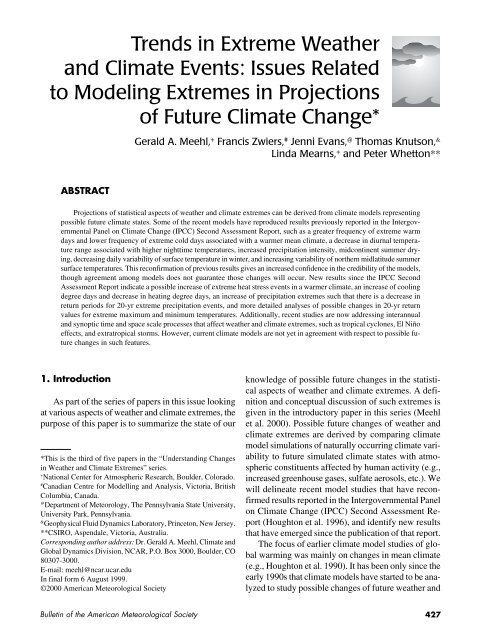
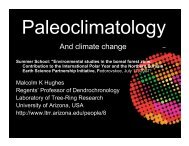


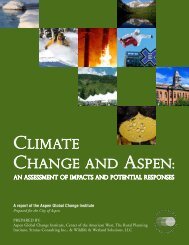

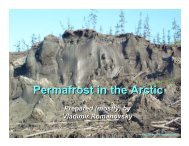
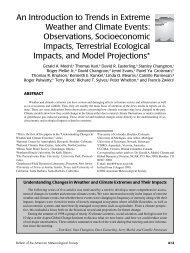
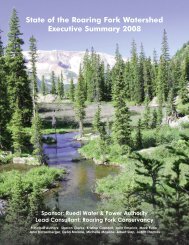
![View Powerpoint Slides [PDF]](https://img.yumpu.com/32486693/1/190x146/view-powerpoint-slides-pdf.jpg?quality=85)


![View Powerpoint Slides [PDF]](https://img.yumpu.com/29411106/1/190x143/view-powerpoint-slides-pdf.jpg?quality=85)
